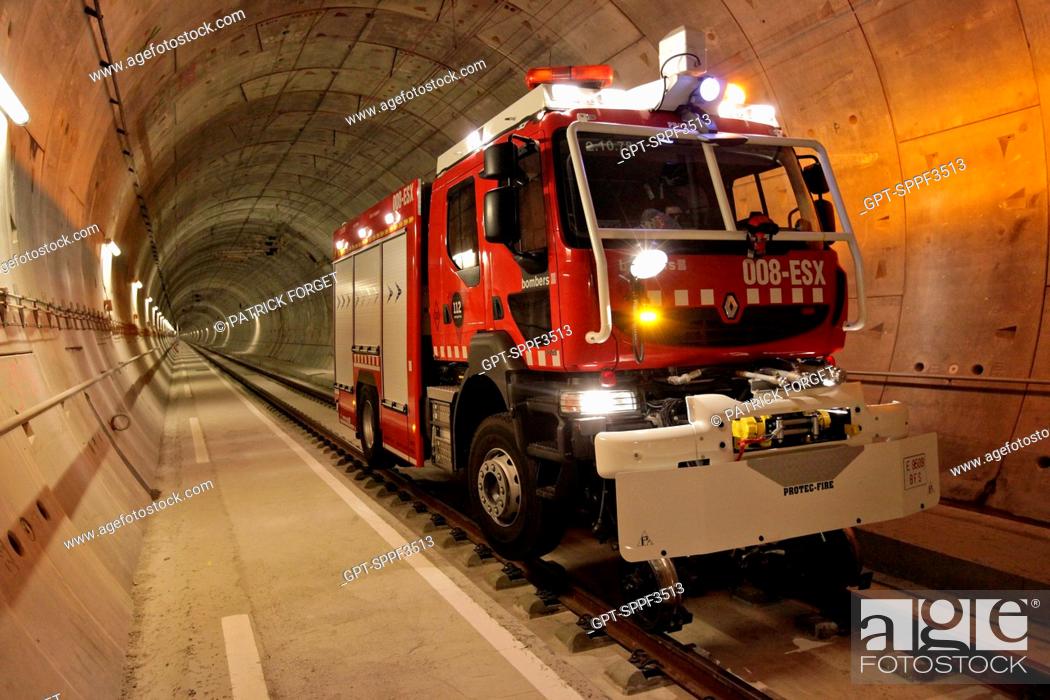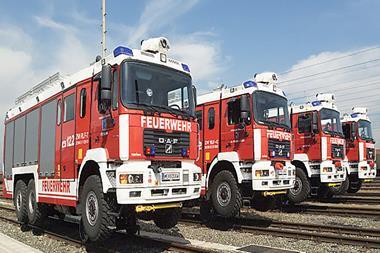The Diabolo Tunnel links Brussels Airport with Europe's high-speed railway network and by using the Eurostar and Thalys super trains, travelers can proceed to Cologne, Amsterdam, Paris or London without changing.
Accordingly, in order to provide the traveling public with maximum safety, the Belgian railway operator Infrabel ordered two special, road-rail fire trucks from Rosenbauer. The vehicles are built on MAN chassis and fitted with 540hp engines. On roads, they use 6x6 all-wheel drive while on the unusual terrain of the tunnel track they employ rail-traveling devices.
The trucks are equipped for extinguishing and rescue operations and possess a comprehensive, top quality system for both their own protection and firefighting. The operational responsibilities linked to this latter area include the 2.127 km-long Diabolo Tunnel, which runs under Brussels Airport. The trucks are driven to the tunnel portals on wheels and then, via a ramp, run onto the track where the six-axle track traveling device is lowered. The vehicles can then race through the tunnel at speeds of up 40 km/h.
Right down the line
Each of the trucks is ready to run on rails in roughly three minutes and no technical aids or lifting gear are required. This railing procedure can be controlled externally via remote cable control, or directly from the driver's cab and the crew does not have to leave the vehicle at any time. Auxiliary cameras on each of the truck's axles monitor this process, in order that the track-traveling device is brought precisely into line. At the same time, the 12 m-long vehicle is lifted hydraulically and the wheels are retracted, thus making the truck ready to run. The cockpit display shows the rail travel mode in which the steering wheel is mechanically blocked. Everything else remains the same for the driver as on the road. The accelerator pedal speeds up the truck and the brake pedal slows it down.
Powerful pumpers ...
As far as extinguishing is concerned, the two identical vehicles are fitted with powerful
N55 pumps (output: 5,000 l/min at 10 bar),
AQUAMATIC combi-foam proportioning systems and
RM25C fender turrets. Depending on requirements, the double AQUAMATIC controls two differing foam tanks, one containing 375 l of Class B foam and the other 125 l of Class A. The water tank holds 2,500 l and LED tank gauges are mounted on the left and right of the bodywork.
Outside the tunnel, during fires in buildings, vehicles and wildland, the road-rail vehicles are deployed as classic rescue pumpers although clearly their special features are in particular demand in the Diabolo Tunnel.
... with special features
These consist primarily of an extensive selection of safety devices. Both vehicles have a pump&roll operational capacity, which means that can move and extinguish simultaneously, as well as spray nozzles for the protection of the cabs. The nozzles are seated on stainless steel lines that run around the outside of the vehicle. The trucks also possess a considerable range of gas measurement technology, in order to determine the concentrations of noxious substances (carbon dioxide, hydrogen sulfide, hydrogen cyanide, etc.) in the tunnel. In addition, 90,000 l of oxygen are carried in reserve for the crew. All the cabin seats, including those of the driver and co-driver, are fitted with a holder for a long-time SCBA (twin-pack devices with 2x 6.8 l bottles) including a direct filling connection. As a result, every crew member has sufficient oxygen for at least three hours.
Furthermore, should the truck's diesel engine shut down due to a shortage of oxygen, it can still leave the tunnel thanks to an auxiliary, emergency drive system. This consists of an e-motor with a capacity of around 16 kW and two lead-acid battery packs. Infrared cameras mounted at the front and rear of the truck provide the crew with vision even if the tunnel is full of smoke and they retain their sense of direction by means of a special, GPS-based navigation system. All the measurement data and the infrared images are shown on the cockpit display.
A full range of rescue equipment
The equipment of the 33 t rescue pumpers includes highly efficient lifting systems such as hydraulic jacks, wedge rams and high-pressure cushions, which allow railway wagons to be raised and re-railed. In addition, a hydraulic winch that can be used in both road and rail operations is integrated into the chassis frame. A set of hydraulic rescue equipment is also installed in the vehicles to free people from trapped wreckage.
The vehicles are fitted with
FLEXILIGHT lighting masts in order to illuminate the operational scene or tunnel. The power required is generated from within the vehicle using an integrated 40 kVA generator, which is indirectly driven by the engine via hydraulic pumps.












